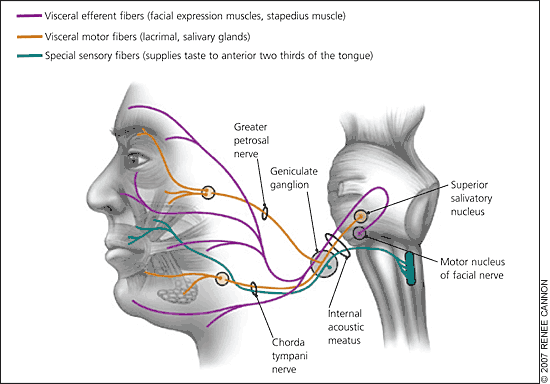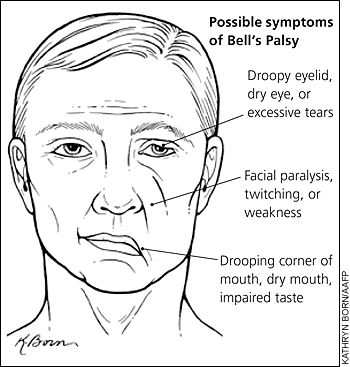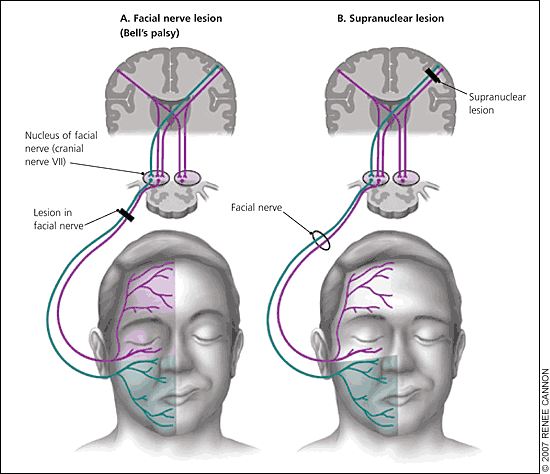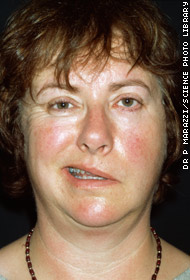
貝爾氏麻痺的歷史:
西元7世紀,就有關於面神經麻痺治療的文字記載。18世紀以後,有了病理生理方面的記錄。此後,隨著對神經生理學方面的知識的認識,擴大並充實了本病的研究範圍。證實了肌肉收縮的神經支配及神經肌肉的電生理現象,特別是,發現損害的神經有再生能力。
Diagnosis 診斷


Pathology
It is supposed to be the result of inflammation of the facial nerve, which produces pressure on the nerve as it exits the skull within its bony canal. Patients with facial palsy for which an underlying cause can be readily found are not generally considered to have Bell's palsy per se. These underlying problems include tumor, meningitis, stroke, diabetes mellitus, head trauma and inflammatory diseases of the cranial nerves (sarcoidosis, brucellosis, etc.) In these conditions, the neurologic findings are rarely restricted to the facial nerve. Babies can be born with facial palsy, and they exhibit many of the same symptoms as people with Bell's palsy; this is often due to a traumatic birth which causes irrepairable damage to the facial nerve, i.e. acute facial nerve paralysis.
One disease that may be difficult to exclude in the differential diagnosis is involvement of the facial nerve in infections with the herpes zoster virus. The major differences in this condition are the presence of small blisters, or vesicles, of the external ear and hearing disturbances, but these findings may occasionally be lacking.
In recent years, two new suspects have been added to the possible causes of Bell's palsy. Lyme disease may produce the typical palsy, and may be easily diagnosed by looking for Lyme-specific antibodies in the blood. In endemic areas Lyme disease may be the most common cause of facial palsy. The subsequent observation of an increased incidence of antibodies to the Herpes simplex virus in patients with Bell's palsy has led many specialists to believe that this agent is the most likely underlying cause in areas where Lyme disease is uncommon.
Epidemiology
Bell's Palsy is three times more likely to strike pregnant women than non-pregnant women .It is also considered to be four times more likely to occur in diabetics than the general population, and it is more common in the elderly than children.
Treatment
Treatment is a matter of controversy. In patients presenting with incomplete facial palsy, treatment may be unnecessary. However, patients presenting with complete paralysis, marked by an inability to close the eyes and mouth on the involved side, are usually treated with anti-inflammatory corticosteroids. The efficacy of this treatment has not been reliably demonstrated. The likely association of Bell's palsy with the herpes virus has led most American neurologists to prescribe a course of anti-viral medication (such as acyclovir) to all patients with unexplained facial palsy. Surgical procedures to decompress the facial nerve have been attempted, but have not been proven beneficial. Acupuncture has also been studied, with inconclusive results.
People who think they may have Bell's Palsy should consult their doctor as soon as possible. Many times, the medications will not be effective if administered too late after the onset.
Although most patients (60–80%) recover completely from Bell's palsy within several weeks, some require several months, and others may be left with deficits of varying degrees.
Complications
Major complications of the condition are chronic loss of taste called ageusia, chronic facial spasm and corneal infections. To prevent the latter, the eyes may be protected by covers, or taped shut during sleep and for rest periods, and tear-like eye drops or eye ointments may be recommended, especially for cases with complete paralysis. Where the eye does not close completely, the reflex is also affected; great care should be taken to protect the eye from injury.
Another complication can occur in case of incomplete or erroneous regeneration of the damaged facial nerve. The nerve can be thought of as a bundle of smaller individual nerve connections which branch out to their proper destinations. During regrowth, nerves are generally able to track the original path to the right destination - but some nerves may sidetrack leading to a condition known as synkinesis. For instance, regrowth of nerves controlling muscles attached to the eye may sidetrack and also regrow connections reaching the muscles of the mouth. In this way, movement of one also affects the other. For example, when the person closes the eye, the corner of the mouth will lift, or when smiling, the eye will close (synkinesis).
In addition, around 6% of patients exhibit crocodile tear syndrome on recovery, where they will shed tears while eating. This is thought to be due to faulty regeneration of the facial nerve, a branch of which controls the lacrimal and salivary glands.
There exists a small, loosely connected network of physical therapists throughout the United States who specialize in treating Bell's Palsy and other forms of facial paralysis. They use refined forms of manual therapy for the face, facial exercises, neuromuscular re-education which includes using proprioceptive facilitation, biofeedback, infra-red laser, sensory electrical stimulation, and nerve conduction studies. This program, with all elements combined together, can see remarkable results in patients who have had their paralysis longer than 6 months, with no real hope of a spontaneous recovery. An extensive internet search can find one of these therapists.






 留言列表
留言列表
 線上藥物查詢
線上藥物查詢 